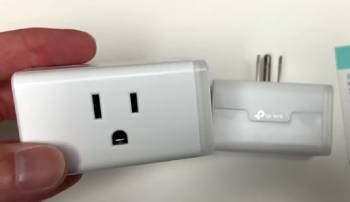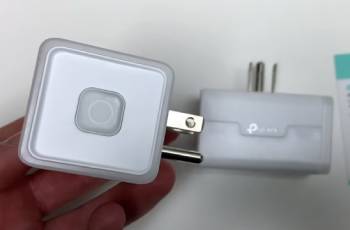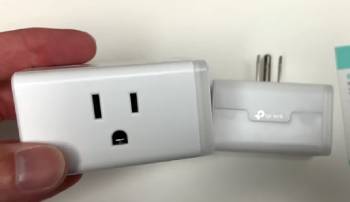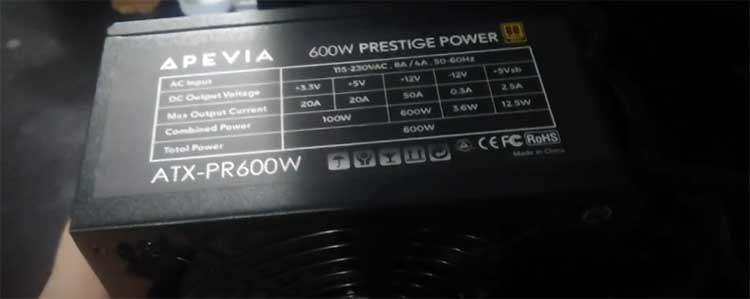If you’re looking for a smart plug that actually works the way it’s supposed to, the Kasa Smart Plug is the one I always recommend.
It’s affordable, reliable, and packed with functionality that genuinely improves your day-to-day life.
Whether you’re starting your smart home journey or adding another piece to the puzzle, this plug fits seamlessly with any setup thanks to Matter support, energy monitoring, voice control, and more.
The setup is easy, the controls are smooth, and you’ll wonder how you ever lived without it.
Now let me tell you why I made it part of my home.
My Experience Using the Kasa Smart Plug

I bought the two-pack of the Kasa Smart Plug HS103P2 when I was looking for a way to automate a few lights around the house.
Initially, I wanted to test them on a couple of lamps and my coffee maker.
From the moment they arrived, everything was shockingly smooth.
Plug them in, open the Kasa app, connect to Wi-Fi, and boom—they were ready to use.
No special hub, no digging through settings, no confusion.
Everything felt intuitive.
But what really surprised me was how fast I started depending on them.
I started using voice commands with Alexa to turn off my living room lamp.
Then I added schedules for the bedroom lights, and even set up the coffee maker to start brewing before I got out of bed.
When I travel, I schedule the lights to come on in the evening so it looks like someone is home.
And when I forget to turn something off before leaving, I can shut it down from the Kasa app in seconds—that kind of remote control brings real peace of mind.
The Matter integration was a bonus.
Since I also use Apple Home and occasionally experiment with Google Home, having that universal compatibility made the experience more unified.
Plus, I was curious about the energy monitoring, and I’ve actually made changes to reduce how much power my coffee machine was drawing by checking usage data weekly.
It may seem small, but those savings add up.
Even after two months of constant use, I haven’t had a single connectivity issue or random failure.
It just works. And for smart home tech, that’s rare.
Why I Trust Kasa Over Other Smart Plugs?
Trust isn’t something I throw around lightly when it comes to tech — especially smart home gear.
With smart plugs, I’ve learned the hard way that not all brands deliver on their promises. Some glitch out during automation, others don’t play well with voice assistants, and a few even heat up or stop responding altogether. That’s where Kasa really sets itself apart for me.
One of the biggest reasons I trust Kasa is consistency. After months of using them, I’ve yet to face a situation where the device randomly goes offline or schedules fail.
Every single time I’ve asked it to turn something on or off, it’s done it — no delays, no hiccups.
That kind of reliability is crucial, especially when you rely on automation for routines like turning off lights at night or setting up security lighting when you’re traveling.
Then there’s transparency. The Kasa app doesn’t bombard me with unnecessary alerts or data collection prompts.
It’s smooth, intuitive, and doesn’t make me jump through hoops to change a simple schedule or link another platform like Alexa or Google Home.
Lastly, I’ve never once felt like I overpaid. In fact, when you compare it to pricier alternatives that don’t offer Matter support or energy monitoring, Kasa still manages to offer more — for less.
So, when friends or family ask me which smart plug they should buy first, I tell them to go with Kasa. It’s the one brand I trust to just work. Every day. Without compromise.
Pros and Cons of Kasa Smart Plug

Pros
- Seamless integration with Alexa, Google Assistant, Siri, and SmartThings
- Matter support makes it compatible with a wide range of devices and platforms
- No hub needed; connects directly via Wi-Fi for simplicity
- Energy monitoring gives real insight into power usage
- Compact design means it doesn’t block adjacent outlets
- Affordable pricing for a high-quality, reliable smart plug
- Voice control and remote access work flawlessly through the app
- App interface is intuitive and easy to navigate
- Allows scheduling, timers, and automation to fit your routine
- LAN control works even without internet due to Matter functionality
Cons
- Doesn’t support high-power devices like heaters or air conditioners
- Requires 2.4GHz Wi-Fi; won’t connect to 5GHz networks
- Needs separate setup for each plug if you buy multiples at once
- Slight delay when triggering commands via app (a second or two)
- App notifications could be more customizable
- Energy data refreshes periodically, not in real-time
- No built-in surge protection—use a power strip if needed
- Not suitable for outdoor use unless paired with a cover
- Voice command feedback varies slightly by assistant used
- Doesn’t store historical data beyond a limited timeframe
Maintenance Tips to Keep Your Kasa Plug Running Smoothly

Clean your smart plug regularly with a soft, dry cloth to avoid dust buildup. Avoid using any liquid or abrasive cleaners on the plug casing.
If you unplug it for any reason, wait a few seconds before plugging it back in to allow a full reset.
Keep your firmware updated using the Kasa app to ensure compatibility and feature upgrades.
Check your Wi-Fi signal strength occasionally—weak signals can affect performance. Avoid overloading the plug by sticking to standard devices (like lamps and small appliances).
For best scheduling performance, always keep your time zone and location settings accurate in the app.
Use a password-protected Wi-Fi network to reduce the risk of unauthorized access. If you move the plug to a new room, re-sync it with the app to confirm connectivity.
Try not to switch outlets frequently; consistency helps maintain performance.
Disable devices in the app when not in use instead of unplugging manually—this keeps automation schedules intact.
Test energy usage insights weekly to understand your habits better. Use the Matter functionality to simplify device control across ecosystems.
In case of any issue, use the in-app support for diagnostics before doing a reset.
Backup your schedules and settings through cloud sync if possible. Finally, enjoy the convenience—that’s what it’s built for.
Also Read: My Thoughts On NGK Iridium Spark Plugs
Kasa Smart Plug Vs. Other Brands
- Kasa Smart Plug Vs. TP-Link Tapo
Since both products come from the same parent company, the TP-Link Tapo smart plug is often seen as the “budget sibling” to the Kasa.
But after trying both, I stuck with Kasa for a few reasons.
The Kasa app is cleaner and more refined, which made everyday use feel more effortless.
Tapo sometimes lags when updating settings or turning devices on/off.
While both support Alexa and Google Home, only Kasa offers Matter support and energy monitoring in the plug I tested.
That extra data and compatibility go a long way when building a smart home over time.
If you just need a plug to turn on a lamp, Tapo works.
But if you care about stability, real-time control, and integration that scales, Kasa feels more complete.
- Kasa Smart Plug Vs. Amazon Smart Plug
Amazon’s own smart plug fits neatly into the Alexa ecosystem.
But the Kasa Smart Plug isn’t limited to one brand.
While Amazon’s version is slick if you’re fully Alexa-based, it doesn’t support Matter, Siri, or Google Home.
Kasa does.
And that flexibility matters when you’re using multiple systems or thinking long-term.
Setup for both is easy, but I found Kasa to be more straightforward, especially when setting schedules or viewing energy data.
The Amazon plug also lacks energy monitoring, which, in my experience, has helped cut unnecessary costs and track device usage more closely.
If Alexa is all you use, Amazon’s plug is solid.
But Kasa gives you more control across more platforms.
- Kasa Smart Plug Vs. Wyze Plug
I tested the Wyze Plug for a few months before switching.
While it was reliable for basic on/off functions, it fell short in some key areas.
The app was occasionally glitchy, and the plug would randomly go offline, forcing me to reconnect.
Kasa, on the other hand, has stayed consistently online and responsive.
Wyze also doesn’t support Matter yet, which made it harder to integrate with my broader smart home setup.
I did like that Wyze offered vacation mode, but Kasa’s scheduling and timer features did the job just as well.
Add energy monitoring to that, and the overall package from Kasa is more advanced.
Wyze might be good for light users, but if you want reliability, you won’t regret picking Kasa.
Also Read: My Thoughts On EIGHTREE Smart Plug
Frequently Asked Questions (FAQs)
Yes, especially if you want a dependable smart plug with wide compatibility, energy tracking, and remote control features.
Avoid plugging in high-powered appliances like heaters, air conditioners, or anything that exceeds the plug’s wattage limit.
The HS103P2 is a top choice for basic use, while models like the KP125 offer advanced features like energy monitoring and Matter support.
Yes, with Matter-certified models, local LAN control still works even if your internet is down.
Final Thoughts
After using the Kasa Smart Plug for months, it has earned a permanent place in my home.
It’s not just about turning things on and off from your phone.
It’s about adding real convenience, control, and peace of mind to your daily routine.
From setup to everyday use, it’s simply one of the most reliable and well-thought-out smart home devices I’ve used.
If you’re ready to make your home smarter the easy way, this is where you should start.
